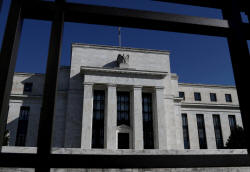U.S. lawmakers likely to press Powell on Fed's 'hawkish' turn
 Send a link to a friend
Send a link to a friend
 [June 22, 2021] By
Howard Schneider [June 22, 2021] By
Howard Schneider
WASHINGTON (Reuters) - Federal Reserve
Chair Jerome Powell on Tuesday will testify in a congressional hearing
likely to focus on how the U.S. central bank is balancing rising
inflation risks with its promise to ensure the economy recovers all the
jobs lost after the onset of the coronavirus pandemic.
Until recently there was little perceived conflict between the Fed's
twin goals of restoring the labor market to maximum employment while
making sure that prices rise at only a modest pace.
But since Powell last appeared before the U.S. House of Representatives
Select Subcommittee on the Coronavirus Crisis, the central bank's
outlook for inflation has doubled. Projections released by the Fed last
week showed prices in 2021 are expected to increase at a 3.4% rate,
compared to the 1.7% projected as of last September.

Recent job growth, meanwhile, has been slower than hoped, with some of
Powell's colleagues now openly suggesting the pandemic prompted so many
people to retire it may be unrealistic to think the economy can return
to the pre-crisis level of employment before the Fed needs to tighten
monetary policy.
That's a stance counter to Powell's own focus on returning the economy
to the conditions of early 2020, and to that of the subcommittee's
influential Democratic chairman, Representative James Clyburn of South
Carolina.
In testimony prepared for delivery at the hearing, Powell restated his
concern that high ongoing joblessness is falling hardest on lower-paid
workers, Blacks, and Hispanics. Recent high inflation was expected to
prove temporary, he said, and the Fed "will do everything we can to
support the economy for as long as it takes to complete the recovery."
Clyburn, who has close ties to President Joe Biden, pushed Powell in a
similar hearing nine months ago to ensure a "fair and equitable" jobs
recovery, and at that point said he felt the Fed's programs had
"prioritized big business over the small ones that are most at risk ...
and it has failed to protect American workers."

The economic landscape has shifted dramatically since then, and at a
policy meeting last week Fed officials responded. They projected they
may raise interest rates as soon as 2023, perhaps a year earlier than
anticipated, and Powell said during a news conference that the central
bank was beginning talks about when to pare down its $120 billion in
monthly purchases of government bonds and securities used to support the
recovery.
[to top of second column] |

Federal Reserve Board
building is pictured in Washington, U.S., March 19, 2019.
REUTERS/Leah Millis

Graphic: Stronger inflation, lower unemployment - https://graphics.reuters.com/USA-FED/yxmvjaawapr/chart_eikon.jpg
Powell told reporters the economy "is still a ways off" from the
progress in rehiring that the Fed has said it wants to see before making
any changes, a cue that the timing of an actual policy shift remains up
in the air.
But the change in tone and projections caught markets off guard, and the
hearing on Tuesday, which begins at 2 p.m. EDT (1800 GMT), will be
closely watched to see how Powell responds to the likely push by
Democrats wanting to gauge if the Fed is hedging its job market
promises, and the pull of Republicans wondering why it is not acting
faster against inflation.
'NOT THE RIGHT BENCHMARK'
Since the June 15-16 policy meeting, the situation has gotten arguably
more complicated for the Fed.
Market trading in inflation-protected securities showed investors
expected a slower pace of price increases - and a potential loss of
faith in the Fed's stated willingness to run a "hot" high-inflation
economy to encourage a full job recovery that reaches marginalized
workers as well as those better off.

Graphic: An upended inflation outlook? -
https://graphics.reuters.com/USA-FED/POWELL/
ygdvzxxldvw/chart_eikon.jpg
Those among Powell's colleagues who have spoken so far, meanwhile, have
pushed a more "hawkish" approach, suggesting both that inflation risks
needed attention, and that the job market was already closer than
thought to full employment because of workers who had retired or
otherwise left the labor market for good.
"The pre-pandemic level of employment is not the right benchmark," St.
Louis Fed President James Bullard said on Monday, pointing to research
that as many as 2.6 million people retired during the pandemic,
accounting for the bulk of the fall in U.S. labor force participation.
Retirements have "changed the calculus about the labor market
dramatically," Bullard said.
(Reporting by Howard Schneider; Editing by Paul Simao)
[© 2021 Thomson Reuters. All rights
reserved.] Copyright 2021 Reuters. All rights reserved. This material may not be published,
broadcast, rewritten or redistributed.
Thompson Reuters is solely responsible for this content. |